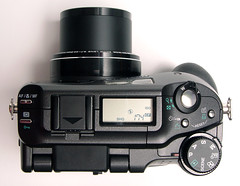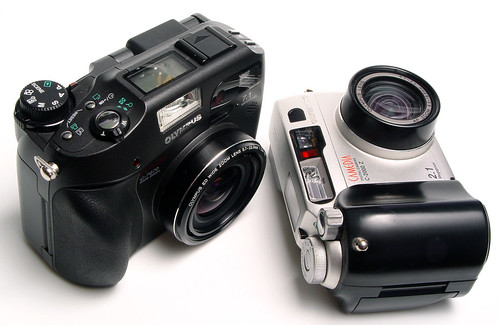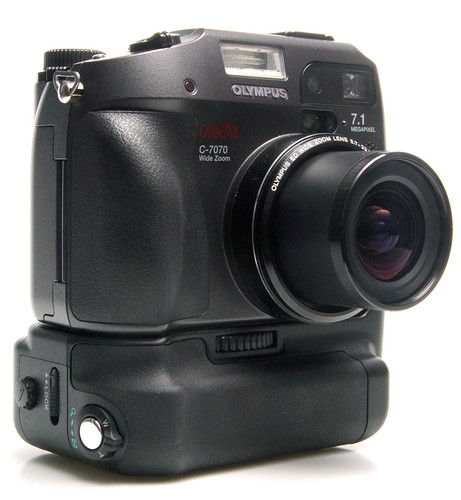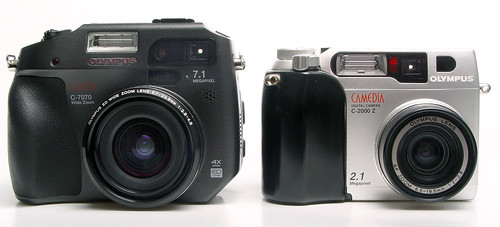Olympus C-7070wz [2005]Pictures Taken By The Other Martin Taylor With This Camera When You Want to Leave the DSLR at HomeNot so long ago, before the Canon Digital Rebel broke the sub-$1000 DSLR price barrier, most enthusiasts carried a camera that belonged to a category manufacturers called "prosumer" (aka "bridge") cameras. The implication was that these cameras would appeal to both advanced enthusiast (consumers) and professional photographers alike. While this was true to some extent, the difference was that, for the enthusiasts, the prosumer digicam was likely to be their main camera whereas, for the pro', it was likely to be their carry camera when they didn't want to take their DSLR kit with them. This was a huge difference in use case; the enthusiasts was using the prosumer camera for the majority/all of their 'work' before they 'stepped up' to a DSLR. Fast forward a couple of years and the prosumer camera is a dying breed. For what the enthusiast used to pay for a high-end compact camera they now have many choices of entry-level DSLRs. In most cases now, someone who wants to start taking their photography more seriously jumps straight from a pocket digicam to a DSLR without bothering to check out an advanced digicam. This democratization of the DSLR is as it should be, but it is a pity that a good prosumer, high-end digicam is getting harder to find. Just as the professionals before us realized, the prosumer digicam has its place; it is not really a substitute for a DSLR but it makes a great carry camera when you don't want to carry the full Monty DSLR kit with you. 
In many ways this is a case of history repeating itself. I'm reminded of the 70's when the rangefinder camera was the carry camera of professional and enthusiast photographers a like; Leica for the pro' and a Canon G17 or the like for the amateur. Then came the Japanese SLR revolution and the rangefinder was sidelined. This was a pity because the rangefinder was still a useful tool in many situations but the SLR was more obviously versatile and camera manufacturers want to sell huge numbers of a product rather than maintain a niche line. Today the rangefinder still exists but they sell in tiny numbers, more often to collectors and equipment snobs than as work horse cameras for average users. In much the same way, the high-end, compact, digital camera is still being made but in fewer numbers than it was before. On certain interweb forums you are seeing arguments from ardent fanboys of the genre that their prosumer digicam is so much more useful than your DSLR. Their arguments are so reminicient of the Rangefinder vs SLR arguments that it's not funny.I don't suggest that you waste your time getting involved in these discusions, nor do I suggest that the protagonist posters are even right but they do have a point or two. The prosumer digicam form is somewhat difficult to define but is usually follows along these lines:
Olympus C-7070 - The End of a Line
Before I bought into the Canon DSLR line my main camera had been the prosumer Sony F717. Recently it has been my work bag camera and it still performed well ... most of the time. It had strarted to develop a fault in its card reader in that it did not always recognise its memory stick and, as Sod's law dictates, this was usually at the most critical moments. Also, the F717 was not much smaller than a SLR so it took up way too much room in my messenger bag. The fact that an under-priced C-7070 should fall into my lap felt like fate. Design: Look and FeelI've always loved the Olympus design astetic. That might be obvious looking through my previous cameras which include the OM SLR line, the XA compacts and the Mju P&S. Olympus cameras have always been favorites of architects and designers which tells you something about their design phillosophy. Understated. compact, elegant and classic are all words that have been used to describe Olympus lines through the decades. The C-7070 format sticks to classic form factor established by the first C-series camera, the C-2000z which, un-coinicendally, happened to be my first decent digital camera. I loved that camera's design As a fan of C-serries design and I am not alone. Back when my C-2000z was released it was often compared in looks to a classic rangefinder. The C-7070 continues this theme with chopped, sloped corners that seem like a dirrect homage to the Bessa R rangefinder. Compared side-by-side, the C-7070 has gained some bulk since the C-2000z although the classic family's lines and are clearly vissible. Pardon the petrolhead metaphor but it's like comparing a Mark I Golf GTi with the latest example of the marque. The original car is lighter and feels more nimble. The new model has gained some weight with age but it is more that it has grown up rather than put on flab. The new model has many more features and utilities, it feels more solid and modern and utilitarian for today's user but it still is true to the original concept and design.
Many of it's most frequently used features and settings are available via dedicated buttons rather than having to dig through menu systems. When you do have to utilize the menu system most features are intuatively located to an advanced enthusiast. I really like the extra custom button that the user can assign one of several controls to. I assign it the ISO setting because I frequently change this exposure control as the lighting situation changes but I could see others using it equally effectively as the drive control. I also really like the thumb wheel for quickly scrolling through settings; it is very DSLR like and a very classy feature that minimises the constant use of the thumbpad. The power switch is a little unusual and there were some negative opnions about it in the reviews I have read. It tahkes the form of a collar that rotates bellow the mode dial. I does take a couple of days to get used to but I like that it is strong and possitive; certainly there's no chance of accidentally turning the camera off or on. Another pro-feature that I like is that the camera sports a real, surge protected hot shoe. This means that you can attach a modern fancy TTL Olympus flash or an old Vivitar 283 just as safefly. There's no PC sync socket but neither is there on my DSLR so using a hot shoe afapter is no big deal for me. Negatives:Just in case you're getting the impression that I think that this is the perfect digicam, let's remember that no camera is perfect, every camera is a series of compromises so let's get a few critisims out of the way Plastic stuff: Lens Cap and memory card door. Many contemporary reviews mention that the lens cap is a press-on affair that drops off if you even look at it funny. This is not an exlusively Olympian problem (my wifes Canon S2 suffers from the same problem for the same reasons) and I understand why manufacturers buiild lens caps this way in an attempt to protect the extending lens mechanism from crashing into something solid at startup. To be honest, the problem is not as bad as I've read about but, still, there's got to be a better solution than this. The memory card door was also reported as flimsy and, again, my experience is that this is true but it's not as bad as some reviewers made out. Perhaps because the rest of the camera is so solidly built these minor plastic quibbles stick out more than they would otherwise. Menus: White Balance settings and scene modes - I find these cumbersome to navigate to and to select. As a results I use them infrequently. Speed: Even in it's day this camera was not considered speedy. Reading and writing to the card is slow, especially when using the RAW file format, It takes over 6 seconds to write a RAW image and you can forget about moving on to the next shot during that time. For this reason I stick with JPED format with this camera unless the exposure situation is especially tricky. Shot to shot time otherwise is OK, but not spectacular. Optical Viewfinder: It's great to find a digicam that still sports an optical viewfinder in addition to the LCD screen; I just wish it were a bit more accurate. It has dialopter adjustment but it only reports about 80% of the actual image you will record. In addition, the viewfinder doesn't display any of the camera's settings or controls. so you have to refer to the LCD on the top of the camera if you want to know what is going on. This is one area digicams with optiical view finders fall far short of their DSLR counterparts. Documentation: I hate that the advanced manual is only in electronic format. There's a hard copy of the getting started document but you'll be done with that in 5 minutes. PDF manuals are all well and good but you can't take them to the little boy's room with you. It happened to Software and now it is affecting appliances - please give us real, paper manuals. ConclusionI think that it is testament to the C-7070 that I have not missed having my DSLR with me all the time in the past 2 weeks. In fact, I have taken the C-7070 out on a couple of local photo shoots where I would normally carry my DSLR kit just because I wanted the freedom of carry one, small camera without the added bulk of a camera bag and additional lenses. I'm definately not saying that the C-7070 is a DSLR replacement for me but it is a great carry camera. The areas where it does fall down when compared to my DSLR are image noise, card writting speed, low light sensativity and the viewfinder display. It's focal range (27-110mm equivellent) is perfect for the street shooter or walkabout photographer. Going back to the rangefinder analogy, this range is similar to the range of prime lenses typically used on rangefinders. 28mm used to be a pretty standard wide angle lens, but it is unusual to find on a digicam and makes the C-7070 really useful not only on the street, but also for interiors and landscapes. The long end isn't very long by today's standards but it is enough for portraits and isolating details. It's macro capabilities are great and, as I don't have an auto focus macro lens for my DSLR, and because I love the extreme DOF you get with digicams, the C-7070 is now my macro camera of choice. For table top and product shots, a real hot shoe and manual controls of all settings as well as its macro capabilities, makes the C-7070 very useful.
Amongst C-series fans, the awarding winning Magnum photographer Alex Majoli is legendary. He used several C-5060 cameras (the 5 megapixel precursor to the C-7070) as his camera of choice in various hard (both physical and emotional) enviroments. It seems that he used the Olympus like a journalist would have used a Leica in the past. He had access to any camera he wanted and he chose the C-5060. I can see why he liked this kind of camera so much and this makes it all the more sad that the C-7070 is the end of this great Olympus line. It seems like Olympus are not the only manufacturers to pull out of the high-end, digicam market and Nikons release for a $600 DSLR is another nail in the coffin for this niche. The only real player left at the moment is Canon with their G7, but that camera cannot write to a RAW format and it doesn't have an articulating screen. I don't think I am the only one who mourns the passing of this kind of camera so I will be doing my best to protect and look after my C-7070 but I can see it getting some heavy use as it is such a useful tool. Hopefully it was built to take the abuse and someone will realize the hole in the current market before mine dies. If you happen to come across a well looked after C-7070 or C-5060 for a good price I highly recommend it as supplement to your DSLR rig. Update (August 2007)I still love my C7070 and carry it with me whenever I don't want to carry an SLR. I wish Olympus would have continued the C line - few manufacturers seem to acknowledge there is a place in their lines for a really high end point and shoot. The C7070 still is a great camera and I have been offered generous amounts of money for it several times but I will keep it until it dies. I love its lens and the fact that it is nice and wide. I like the ability to shoot RAW when I need to (I just wish it was faster in RAW mode). I find the articulating LCD screen surprisingly useful. If it did die or get stolen today I would seriously consider the Canon G7 but the G7 lacks all the features I listed above that really distinguish the C7070. When the G7 came out my wife seriously wanted it so we went down to Calumet and played with it a good bit and took some test shots we took home and poured over. In your hand the G7 is really nice and solid - it is metal bodied and all the controls, especially the control wheel, are great - I especially liked the ISO selector on the top plate. It is quite a lot smaller and significantly more pocketable than the C7070. One thing I don't like about the C7070 is the noise on any ISO setting above 100. The G7 seems to have a lot more options - going up to 3200! Looking at my test shots there was noise in the shadows even at 100 ISO; 200-400 were usable but not that much better than the C7070. The G7's lens is nice - a lot stronger than the C7070 at the long end but not as wide. I shoot the C7070 a lot of the time as wide as I can so I would miss that. The image stabilization is also a great feature that helps shoot in lower light situations with the G7. The difference between the G7's 10 megapixels and the C7070's 7 megapixels sounds significant but in the real world I actually prefered the files the C7070 makes. I've printed them at 13x19" and it's hard to tell the difference between files made bu the C7070 and my DSLR. As I said, if my C7070 died I would seriously consider the G7 but I don't see it as an upgrade candidate, just a replacement option. Links
Pictures Taken By The Other Martin Taylor With This Camera Comments
Absolutely agreed. My C5050 still surprises me. I haven't used an SLR for 4 years because of this brilliant device! Just set some preset focus lengths in MyMode and it's old school fast to shoot with. Only now am I looking to 'upgrade' and scratching my head as to what to have - this market area is barren. Posted by: Velociphile at June 18, 2007 8:44 AM |
|
All content © 2003-2011 the other Martin Taylor.
 The Olympus C-7070 is a great example of the
prosumer form. Sadly it
is also the end of the fabulous Olympus C-series line and so, also, is
an
indicator of the fate of high end compact cameras. In the US the C-7070
was available in February of 2005; by early October it was no longer
available at major camera retailers. One can only guess that the line
was no longer profitable as Olympus now concentrates its efforts on
smaller, sexy, consumer digicams and its four thirds DSLR system. Where
the
C-series of cameras used to bridge the gap between the two there is now
a hole in the line. Scarcity has made the C-7070 and the
C-5060
that preceeded it, something of cult-cameras with the
C-7070
now fetching prices on eBay in excess of what it
sold for when new. I was suprised, then, to come across someone selling
one
for $200 on Craigslist and snapped it up.
The Olympus C-7070 is a great example of the
prosumer form. Sadly it
is also the end of the fabulous Olympus C-series line and so, also, is
an
indicator of the fate of high end compact cameras. In the US the C-7070
was available in February of 2005; by early October it was no longer
available at major camera retailers. One can only guess that the line
was no longer profitable as Olympus now concentrates its efforts on
smaller, sexy, consumer digicams and its four thirds DSLR system. Where
the
C-series of cameras used to bridge the gap between the two there is now
a hole in the line. Scarcity has made the C-7070 and the
C-5060
that preceeded it, something of cult-cameras with the
C-7070
now fetching prices on eBay in excess of what it
sold for when new. I was suprised, then, to come across someone selling
one
for $200 on Craigslist and snapped it up. In an age where cameras have been getting
smaller and more fiddly
with plastic seemingly the material of choice, the C-7070 is
reassuringly solid. It's black metal body is both tough and
tool-like and yet beautiful and elegant at the same time.
The rubber finger grip provides a solid, secure surface to
hold
on to with little fear of accidentally dropping the camera. From the
front it looks more like a rangefinder than ever while the reverse is
not as elegant, it more than does the job. The articulated
screen
feels possitive and solid an not at all fimbsy. The hinge
that
surrounds the optical viewfinder is not as subtle as other
solutions I have seen but it does meen that the first possition you hit
when you flip the screen out is looking down on to the screen, TLR
style. I found this position emensly useful for candids on my Sony F717
and the C-7070's articulated screen is even more flexible. I especially
like the security of being able to flip the screen totally around so
that it is covered and not exposed when you are carrying the camera -
with this feature there is no worry of scratching the LCD.
In an age where cameras have been getting
smaller and more fiddly
with plastic seemingly the material of choice, the C-7070 is
reassuringly solid. It's black metal body is both tough and
tool-like and yet beautiful and elegant at the same time.
The rubber finger grip provides a solid, secure surface to
hold
on to with little fear of accidentally dropping the camera. From the
front it looks more like a rangefinder than ever while the reverse is
not as elegant, it more than does the job. The articulated
screen
feels possitive and solid an not at all fimbsy. The hinge
that
surrounds the optical viewfinder is not as subtle as other
solutions I have seen but it does meen that the first possition you hit
when you flip the screen out is looking down on to the screen, TLR
style. I found this position emensly useful for candids on my Sony F717
and the C-7070's articulated screen is even more flexible. I especially
like the security of being able to flip the screen totally around so
that it is covered and not exposed when you are carrying the camera -
with this feature there is no worry of scratching the LCD. In your hands, the C-7070 feels right and
solid. It's pretty big for a compact camera but, by SLR standards, it is tiny. I
also love it's understated good looks. Out and about, anyone but a
camera geek could easily mistake the C-7070 for a consumer P&S.
This makes it very easy to disappear in the crowd - another
rangefinder trait. The articulated screen allows for
interesting
shooting angles; I really like using it TLR style, looking down onto
the LCD. In this configuration people are less likely to
realize
that they are the subject of a photograph and so will continue to
ignore you.
In your hands, the C-7070 feels right and
solid. It's pretty big for a compact camera but, by SLR standards, it is tiny. I
also love it's understated good looks. Out and about, anyone but a
camera geek could easily mistake the C-7070 for a consumer P&S.
This makes it very easy to disappear in the crowd - another
rangefinder trait. The articulated screen allows for
interesting
shooting angles; I really like using it TLR style, looking down onto
the LCD. In this configuration people are less likely to
realize
that they are the subject of a photograph and so will continue to
ignore you.